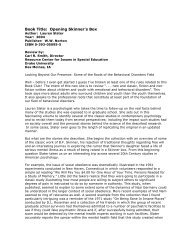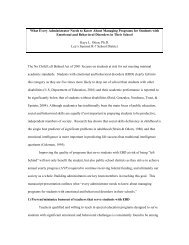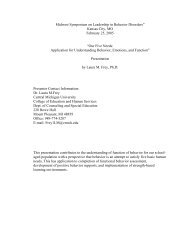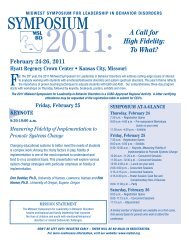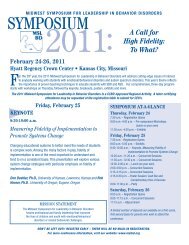Alternatives to Suspension and Expulsion
Alternatives to Suspension and Expulsion
Alternatives to Suspension and Expulsion
You also want an ePaper? Increase the reach of your titles
YUMPU automatically turns print PDFs into web optimized ePapers that Google loves.
What Every Administra<strong>to</strong>r Needs <strong>to</strong> Know About<br />
<strong>Alternatives</strong> <strong>to</strong> <strong>Suspension</strong> <strong>and</strong> <strong>Expulsion</strong><br />
Reece L. Peterson, Ph.D.<br />
University of Nebraska-Lincoln<br />
Overview<br />
This brief report will identify why school discipline systems should be overhauled, <strong>and</strong><br />
will suggest that is possible <strong>to</strong> provide lots of alternative consequences which have a chance of<br />
changing student behavior more than the traditional consequence of “suspension”. We will go on<br />
<strong>to</strong> suggest ways that a school can establish underlying supports which will enable an improved<br />
school discipline system <strong>to</strong> be effective. If this happens, we have a chance <strong>to</strong> improve student<br />
behavior, <strong>and</strong> eliminate many of the problems in our current discipline systems.<br />
Problems with School Discipline<br />
Much attention has been directed at school discipline procedures over the past several<br />
years. Most of this attention has been focused on “exclusionary” consequences, where students<br />
are suspended or expelled from being able <strong>to</strong> participate in school <strong>and</strong> related activities.<br />
This attention has been the result of a variety of fac<strong>to</strong>rs including:<br />
• Media reports about incidents of extreme school violence which has occurred over the<br />
past ten years<br />
• Implementation in many schools of “zero <strong>to</strong>lerance” discipline policies originally<br />
intended <strong>to</strong> reduce behavior problems through consistent harsh punishment for any<br />
inappropriate behavior.<br />
• Over reliance on suspension as the primary school discipline consequence in many<br />
schools
• Over-representation of racial <strong>and</strong> ethnic minorities among those who are suspended or<br />
expelled, <strong>and</strong> even for those referred <strong>to</strong> the office.<br />
• Concern about legal requirements regarding the discipline of students with disabilities<br />
which have been incorporated in IDEA<br />
• Emergence of data which seems <strong>to</strong> indicate that suspension <strong>and</strong> expulsion are not<br />
effective procedures <strong>to</strong> change student behavior<br />
• Emergence of data that suggest long term negative side effects of suspension <strong>and</strong><br />
expulsion including school drop out, increased crime, etc.<br />
• Focus on academic outcomes for all students which has focused attention on the negative<br />
academic consequences for students who are suspended or expelled.<br />
• Development <strong>and</strong> growth in the implementation of school-wide positive behavior<br />
supports<br />
As a result of these fac<strong>to</strong>rs, many schools have tried <strong>to</strong> reduce their use of suspension or<br />
expulsion. Although we are concerned about both suspension <strong>and</strong> expulsion, we will focus<br />
mostly on reducing the use of suspension, since that would likely also be likely <strong>to</strong> reduce the rate<br />
of expulsions as well. Usually this effort focuses on revising school discipline policies <strong>and</strong> “codes<br />
of conduct”.<br />
It may be time for a major overhaul of school codes of conduct- <strong>to</strong> make them more<br />
sophisticated <strong>and</strong> permit more options for responses <strong>to</strong> behavioral situations. Many school’s<br />
codes of conduct are antique documents which may have never been clearly conceptualized. As<br />
new “problem behaviors” have emerged in students (hooded jackets, cell phones, etc.) these have<br />
simply been added <strong>to</strong> a laundry list of banned behaviors. Moreover as new banned behaviors have<br />
been added, few new consequences have been added, <strong>and</strong> often the consequences are not matched<br />
in any way <strong>to</strong> the nature of the offense. There is no longer any semblance of “logical<br />
consequences” in this system. For example a student involved in a fight might be suspended, but
one caught violating the school rule for chewing gum might be suspended, as well as a student<br />
who has been tardy <strong>to</strong>o many times.<br />
In order <strong>to</strong> make school codes of conduct effective we need <strong>to</strong> make them more<br />
sophisticated, <strong>and</strong> more responsive <strong>to</strong> the variety of situations <strong>and</strong> needs related <strong>to</strong> student<br />
behavior. We also need <strong>to</strong> move away from the traditional idea that these consequences are<br />
“punishment” <strong>and</strong> instead focus on our job <strong>to</strong> be effective in changing student behavior. We need<br />
<strong>to</strong> develop a “teaching” orientation <strong>to</strong> the consequences we employ. We also need <strong>to</strong> greatly<br />
exp<strong>and</strong> the number <strong>and</strong> variety of consequences which are included. But equally importantly, we<br />
may need <strong>to</strong> organize <strong>and</strong> relate the consequences <strong>to</strong> the offenses. For example it is possible <strong>to</strong><br />
imagine a tiered “Code of conduct” which identifies levels or categories of offenses, <strong>and</strong> which<br />
also has levels or categories of consequences which might be assigned based on the best<br />
judgment of the administra<strong>to</strong>r or behavior team.<br />
Alternative Discipline Consequences<br />
However before a school can substantially reduce reliance on exclusionary consequences,<br />
most administra<strong>to</strong>rs are concerned about identifying “alternative” consequences- what would<br />
replace the “suspension” if its use was diminished. Many school systems may already employ<br />
some other options for disciplinary consequences. His<strong>to</strong>rically these have included “detention”<br />
(having students stay after school for specified amounts of time), or Saturday school (having<br />
student come <strong>to</strong> school on a Saturday such as depicted in the movie “The Breakfast Club”) for<br />
some schools. And certainly the “trip <strong>to</strong> the principal’s office” is itself a consequence. While<br />
these may be useful options, they are probably not in themselves adequate. What are some<br />
alternatives <strong>to</strong> suspension? How can they be identified?<br />
It is possible for most administrative teams, particularly if they can involve a larger<br />
school-wide team, <strong>to</strong> identify lots of creative ideas for additional alternatives for discipline, <strong>and</strong> it<br />
is best if these emerge from the culture of a particular school. This will also build the support for<br />
these alternatives among teachers, staff, students <strong>and</strong> parents. The examples which follow are
some promising examples of the kinds of alternatives a school might choose <strong>to</strong> incorporate.<br />
Many more might be generated, but all should be within the framework of moving away from<br />
punishment, <strong>and</strong> providing alternatives which match up <strong>to</strong> student behavior <strong>and</strong> needs. It is only<br />
when a variety of these are implemented that they become valuable- any one is probably not all<br />
that helpful by itself. The following ten examples of disciplinary consequences are not presented<br />
in any particular order of priority:<br />
• Mini Courses. Schools could develop short self st<strong>and</strong>ing units or modules on <strong>to</strong>pics<br />
related <strong>to</strong> various types of inappropriate behavior. These could include readings, videos,<br />
workbooks, tests <strong>and</strong> oral reports. These could focus on <strong>to</strong>pics from inappropriate<br />
language, sexual harassment, <strong>to</strong> alcohol/drug use, conflict resolution, social skill<br />
development, <strong>and</strong> many more. Once created, students could be assigned <strong>to</strong> complete the<br />
appropriate modules based on their offense.<br />
• Parent Involvement/Supervision. Parents can be invited <strong>to</strong> help school administra<strong>to</strong>rs<br />
<strong>to</strong> identify ways that they can provide closer supervision <strong>to</strong> their children while in school<br />
or be more involved with their child’s schooling. One good example might be <strong>to</strong> suspend<br />
the student’s parents if willing <strong>to</strong> sit with the student while the student remains in school.<br />
While this example may not always be possible for some parents, it could be a valuable<br />
option. But there may also be many other ways of increasing the contacts <strong>and</strong><br />
communication between parents <strong>and</strong> school around student behavior.<br />
• Counseling. For certain “offenses” students might be assigned <strong>to</strong> required counseling<br />
sessions with appropriately trained professionals (social workers, counselors, school<br />
psychologists, etc.) who can do problem solving with the student, identify areas of<br />
needed skill development (such as Anger management), <strong>and</strong> provide a chance for<br />
students <strong>to</strong> work through problems.
• Community Service. Students might be assigned community service tasks with<br />
appropriate supervision outside of school hours in helping programs or agencies. These<br />
might include other schools, clean up crews, or community agencies. This might<br />
strengthen ties with the community, <strong>and</strong> develop positive community relationships for<br />
students with other adults.<br />
• Behavior moni<strong>to</strong>ring. A variety of strategies could be implemented <strong>to</strong> closely moni<strong>to</strong>r<br />
behavior or a particular student. These could include teacher <strong>and</strong> parent behavior check<br />
sheets, charts of behavior, <strong>and</strong> feedback sessions for the student about behavior. As a<br />
result they might also foster appropriate positive feedback from teachers <strong>and</strong> parents<br />
when appropriate behavior occurs.<br />
• Restitution. Students could be assigned <strong>to</strong> provide work which would repair or res<strong>to</strong>re<br />
environments they may have damaged. This could include cleaning up graffiti, or<br />
repairing acts of v<strong>and</strong>alism. These could also include other related projects <strong>to</strong> clean or<br />
make attractive the school environment.<br />
• Problem Solving or Behavioral Contracting. A defined procedure for behavioral<br />
problem solving <strong>and</strong> then creating a behavioral contract, including positive consequences<br />
for completion of the contract, could be created for specific students where this might be<br />
useful.<br />
• Alternative Programming. For some students, especially at the secondary level, it may<br />
be possible <strong>to</strong> identify changes in the student’s schedule, classes or program which would<br />
avoid problem environments or situations, but yet permit continued access <strong>to</strong> curriculum<br />
<strong>and</strong> school. This could include independent study, work-experience, or other creative<br />
programming alternatives.<br />
• Appropriate In-school <strong>Suspension</strong>. When students are sent <strong>to</strong> an alternative in-school<br />
environment, it is important <strong>to</strong> have that environment continue academic or other
instruction, but <strong>to</strong> also have a focus on solving the problem that resulted in the student<br />
being sent <strong>to</strong> this environment. All <strong>to</strong>o often these environments permit students <strong>to</strong><br />
“escape” without addressing the needed changes by both the sending teachers, <strong>and</strong> the<br />
student <strong>to</strong> actually address the problem.<br />
• Coordinated Behavior Plans. Some students may need the coordination of having all of<br />
the adults in their environment “on the same page” regarding that student’s behavior.<br />
Thus a behavior intervention plan, might provide a map of how a school will address this<br />
behavior. While these types of plans are required for some special education students,<br />
there is no reason that they could not also be employed for other students as well.<br />
School-wide Supports for Discipline <strong>Alternatives</strong><br />
In addition <strong>to</strong> these alternative consequences there are likely some other “prerequisites”<br />
which might make it more likely that these alternatives are effective. These are school-wide<br />
“supports” for behavior which may also play a role in preventing inappropriate behavior from<br />
occurring before it becomes a discipline issue. Many if not all of the following ten supports<br />
should be in place in order <strong>to</strong> make a more sophisticated discipline code effective:<br />
• Gather data on behavior which permits analysis <strong>and</strong> action. Develop a school data<br />
system which permits administra<strong>to</strong>rs or a building team <strong>to</strong> examine <strong>and</strong> use data about<br />
student behavior. This could include office referral data, surveys of parents, staff <strong>and</strong><br />
students, grade <strong>and</strong> academic achievement assessment data, <strong>and</strong> other indica<strong>to</strong>rs of<br />
student involvement in school (attendance, tardiness, drop out rate, rate of participation in<br />
school activities, etc.). Use this data <strong>to</strong> make <strong>and</strong> evaluate changes in policies <strong>and</strong><br />
practices.<br />
• Create a caring <strong>and</strong> welcoming school environment. Create a <strong>to</strong>ne of belong, <strong>and</strong><br />
valuing of individuals. Make everyone feel welcomed <strong>and</strong> valued at school. Make the<br />
environment clean, engaging <strong>and</strong> supportive of educational goals.
• Create an explicit set of school values. Establish a set of school values or character<br />
traits which are supportive of positive behavior <strong>and</strong> which are unders<strong>to</strong>od <strong>and</strong> used by all<br />
staff in their work with students. It is important <strong>to</strong> provide school staff with a language <strong>to</strong><br />
be able <strong>to</strong> communicate these <strong>to</strong> students, <strong>and</strong> <strong>to</strong> encourage teachers in particular <strong>to</strong> find<br />
<strong>and</strong> provide support for expressions of these values in their day <strong>to</strong> day work with<br />
students. Some character education programs might be one way <strong>to</strong> do this.<br />
• Provide conflict de-escalation training. Train all staff, but especially teachers in how<br />
<strong>to</strong> de-escalate conflict, <strong>and</strong> avoid power struggles. This will help by keeping minor<br />
conflicts from getting <strong>to</strong> the point of being discipline problems.<br />
• Mediation programs. Teach students <strong>and</strong> staff about non-violent conflict resolution<br />
strategies, <strong>and</strong> permit students <strong>and</strong> staff <strong>to</strong> use <strong>and</strong> experience these in school related <strong>to</strong><br />
significant school issues. Peer mediation may be one example, but could be exp<strong>and</strong>ed <strong>to</strong><br />
include mediation of some teacher-student conflicts.<br />
• Increase opportunities for positive reinforcement for appropriate student behavior.<br />
The general level of positive reinforcement should be maximized. Increase the amount of<br />
positive reinforcement which occurs in the building for any type of appropriate behavior<br />
by students. Make sure that all teachers work hard <strong>to</strong> identify, acknowledge <strong>and</strong> strongly<br />
reinforce good behavior. Some schools have implemented positive office referral systems<br />
for good behavior, as well as special recognitions/awards for behavior, which are parallel<br />
<strong>to</strong> their academic recognition activities.<br />
• Build communication <strong>and</strong> involvement with all parents. Exp<strong>and</strong> <strong>and</strong> improve<br />
communication with parents, particularly parents of “at-risk” students. Explore multiple<br />
options <strong>and</strong> opportunities <strong>to</strong> build relationships with parents <strong>and</strong> involve them with<br />
school in multiple ways.
• Provide opportunities for building adult student relationships. Encourage staff <strong>to</strong><br />
engage in conversations with students, <strong>to</strong> get <strong>to</strong> know them individually as people <strong>and</strong> <strong>to</strong><br />
share their own s<strong>to</strong>ries <strong>and</strong> beliefs.<br />
• Intervene earlier when signs of behavioral issues first become apparent. Proactively<br />
watch for warning signs that kids are in trouble, <strong>and</strong> then take action <strong>to</strong> explore <strong>and</strong><br />
address the problems before they get <strong>to</strong> the point of being discipline problems. Devise<br />
ways <strong>to</strong> screen students for problems (declining grades, poor attendance, etc.) <strong>and</strong> then<br />
take action.<br />
• School wide discipline <strong>and</strong> behavior system. Make sure that a common terminology<br />
<strong>and</strong> consistent approach <strong>to</strong> behavior is in place across all staff. Responsibilities related <strong>to</strong><br />
behavior for all staff should be identified, school wide rules in place, <strong>and</strong> both positive<br />
<strong>and</strong> negative consequences unders<strong>to</strong>od <strong>and</strong> communicated.<br />
There may be additional formulations of supports for appropriate behavior in schools beyond<br />
these, but these ten would be an excellent start. While it is clearly not possible <strong>to</strong> implement all of<br />
these at one time, it is possible <strong>to</strong> develop a long range plan, <strong>and</strong> <strong>to</strong> begin implementation of these<br />
supports.<br />
Suggestions for Administra<strong>to</strong>rs<br />
Many problems exist with our current school discipline codes, <strong>and</strong> the limited options<br />
<strong>and</strong> punitive rather than educational nature of these systems. Administra<strong>to</strong>rs can begin <strong>to</strong> change<br />
these systems <strong>to</strong> better reflects our goals, <strong>and</strong> thus <strong>to</strong> also better meet the needs of our students,<br />
<strong>and</strong> the learning environments we supervise. Administra<strong>to</strong>rs can begin the process of making<br />
student “codes of conduct” more sophisticated, <strong>and</strong> <strong>to</strong> have a broader <strong>and</strong> more useful set of<br />
consequences. Administra<strong>to</strong>rs can also establish supports in their building, which will enable<br />
discipline codes <strong>to</strong> be effective. In so doing we may diminish the problems associated with the<br />
exclusionary discipline consequences of suspension <strong>and</strong> expulsion.
Resources <strong>and</strong> Links<br />
Peterson, R. (Spring, 2005). Ten <strong>Alternatives</strong> <strong>to</strong> <strong>Suspension</strong>. Impact, 18(2), 10-11. (Impact is a<br />
publication of the College of Education & Human Development, University of<br />
Minnesota.). http://ici.umn.edu/products/impact/182/default.html<br />
Peterson, R.L., Miller, C, & Skiba, R. (Spring, 2004). A Framework for Planning Safe <strong>and</strong><br />
Responsive Schools. Beyond Behavior, 13(3), 12-16.<br />
Skiba, R., Peterson, R., Miller, C., Ritter, S. & Simmons, A. (2004). The Safe <strong>and</strong> responsive<br />
schools project: A school reform model for implementing best practices in violence<br />
prevention. Chapter 40. Submitted <strong>to</strong> the H<strong>and</strong>book of School Violence <strong>and</strong> School<br />
Safety: From Research <strong>to</strong> Practice.<br />
Skiba R. J., Peterson, R. L. & Williams, T. (January, 1999). The dark side of zero <strong>to</strong>lerance:<br />
Can punishment lead <strong>to</strong> safe schools? Phi Delta Kappan, 80(5), 372-381. Condensed <strong>and</strong><br />
republished in Education Digest.<br />
Skiba R. J., Peterson, R. L. & Williams, T. (August, 1997). Office referrals <strong>and</strong> suspension:<br />
Disciplinary intervention in middle schools. Education <strong>and</strong> Treatment of Children,<br />
20(3), 1-21.<br />
Web Resources<br />
The American Bar Association Juvenile Justice Committee Report on “Zero Tolerance Policy”.<br />
http://discussions.abanet.org/crimjust/juvjus/zero<strong>to</strong>lreport.html<br />
Institute on Community Integration, University of Minnesota. A variety of brief articles are<br />
available on this website. http://ici.umn.edu/products/newsletters.html<br />
Institute on Violent <strong>and</strong> Destructive Behavior, University of Oregon.<br />
http://darkwing.uoregon.edu/~ivdb/<br />
The Safe <strong>and</strong> Responsive Schools Project, University of Nebraska-Lincoln/Indiana University.<br />
For more information about how <strong>to</strong> employ a building-wide planning strategy <strong>to</strong> address
improved discipline, as well as a variety of fact sheets addressing many related <strong>to</strong>pics see<br />
the materials at each of the Safe <strong>and</strong> Responsive Schools Websites:<br />
http://www.unl.edu/srs <strong>and</strong> http://www.indiana.edu/~safeschl.




